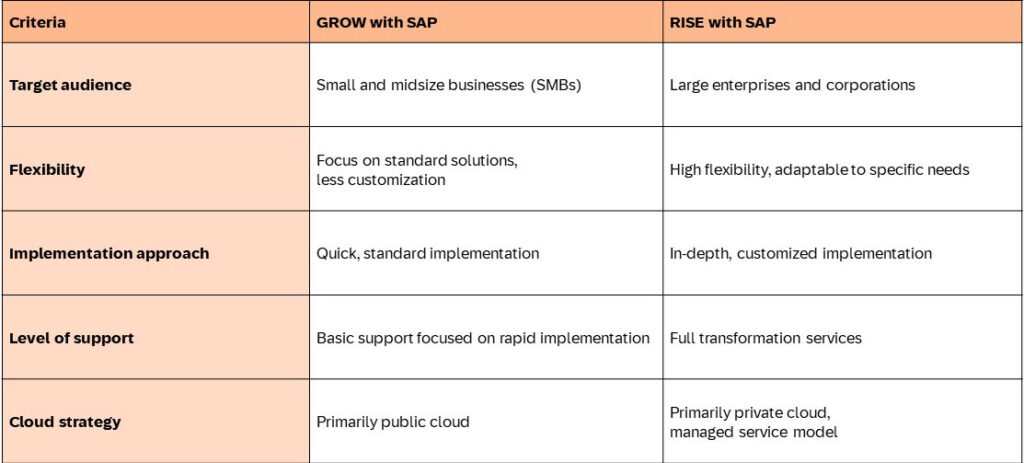Migrating to a cloud ERP system is a critical step in digital transformation.
IT executives should focus on three strategic considerations: choosing between the GROW with SAP and RISE with SAP offerings, exploring possible migration paths, and making necessary IT infrastructure adjustments.
Implementation Approach
RISE with SAP and GROW with SAP differ significantly in terms of methodology, target audience, and objectives.
GROW with SAP is ideal for small and midsize businesses (SMBs) that want to move to a modern cloud ERP system quickly and cost-effectively. With preconfigured solutions and standardized processes, companies can easily take advantage of the benefits of the cloud with minimal effort and in a short timeframe. They can choose from several scenarios based on industry best practices.
RISE with SAP, on the other hand, is designed for large enterprises and corporations seeking a comprehensive transformation. The offering goes well beyond ERP functionality to help provide comprehensive management and optimization services as well as migration support. This robust support can enable companies to migrate their entire IT landscape to the cloud while developing new digital business models.

Transformation Paths
A key aspect of migrating to SAP S/4HANA is the variety of transformation paths available to companies. These paths can offer the flexibility needed to tailor the migration to specific requirements and the existing system landscape.
- System conversion (brownfield approach): This approach enables the migration of an existing SAP ERP system to SAP S/4HANA. It is particularly suitable for companies that want to retain their existing business processes. A key advantage is that the existing database and configuration are retained, which significantly reduces the transition time.
- New implementation (greenfield approach): This method involves starting from scratch and allows organizations to redefine their business processes without being constrained by existing limitations. It provides the opportunity to implement the latest best practices. However, the planning and preparation phases typically take a relatively long time.
- Selective data transition (hybrid approach): This approach combines elements of the two methods described above. It is best suited for organizations that want to preserve certain historical data and processes while phasing in new functionality.
Infrastructure: Adapt or Transform?
Migrating to SAP S/4HANA requires adapting the IT infrastructure to take full advantage of the platform’s capabilities.
- Cloud migration: Many companies choose to migrate to the cloud to improve scalability and flexibility. The choice of public or private cloud depends on an organization’s specific requirements and security strategy.
- Integration and data management: Migrating to SAP S/4HANA requires a thorough review and optimization of integration scenarios and data management strategies. SAP Business Technology Platform (SAP BTP) can provide many tools to help support and enhance these processes.
- Security and compliance needs: Moving to the cloud brings new security and compliance challenges. Careful planning and implementation are essential to protect sensitive data and meet regulatory requirements.
By aligning these three key components – implementation approach, migration path, and infrastructure – organizations can achieve a successful SAP S/4HANA migration.
Guide to a Successful Transformation
The points above provide an initial overview of the challenges and decisions involved in migrating to SAP S/4HANA. However, this only scratches the surface. For IT executives who want to go deeper, the new “Mapping Your Journey to SAP S/4HANA” guide is a comprehensive resource. It provides detailed background information, real-world examples, and additional links that can be valuable to organizations planning to migrate to cloud ERP and those amid the process.
Thomas Bamberger is president of SAP Customer Evolution.



